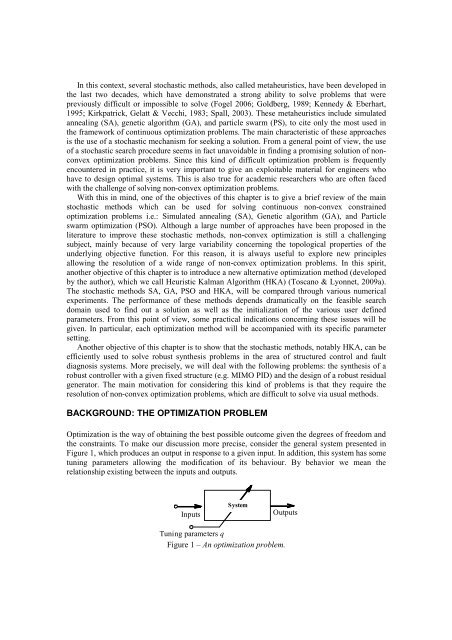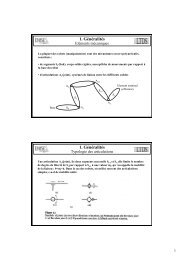q - Rosario Toscano - Free
q - Rosario Toscano - Free
q - Rosario Toscano - Free
You also want an ePaper? Increase the reach of your titles
YUMPU automatically turns print PDFs into web optimized ePapers that Google loves.
In this context, several stochastic methods, also called metaheuristics, have been developed in<br />
the last two decades, which have demonstrated a strong ability to solve problems that were<br />
previously difficult or impossible to solve (Fogel 2006; Goldberg, 1989; Kennedy & Eberhart,<br />
1995; Kirkpatrick, Gelatt & Vecchi, 1983; Spall, 2003). These metaheuristics include simulated<br />
annealing (SA), genetic algorithm (GA), and particle swarm (PS), to cite only the most used in<br />
the framework of continuous optimization problems. The main characteristic of these approaches<br />
is the use of a stochastic mechanism for seeking a solution. From a general point of view, the use<br />
of a stochastic search procedure seems in fact unavoidable in finding a promising solution of nonconvex<br />
optimization problems. Since this kind of difficult optimization problem is frequently<br />
encountered in practice, it is very important to give an exploitable material for engineers who<br />
have to design optimal systems. This is also true for academic researchers who are often faced<br />
with the challenge of solving non-convex optimization problems.<br />
With this in mind, one of the objectives of this chapter is to give a brief review of the main<br />
stochastic methods which can be used for solving continuous non-convex constrained<br />
optimization problems i.e.: Simulated annealing (SA), Genetic algorithm (GA), and Particle<br />
swarm optimization (PSO). Although a large number of approaches have been proposed in the<br />
literature to improve these stochastic methods, non-convex optimization is still a challenging<br />
subject, mainly because of very large variability concerning the topological properties of the<br />
underlying objective function. For this reason, it is always useful to explore new principles<br />
allowing the resolution of a wide range of non-convex optimization problems. In this spirit,<br />
another objective of this chapter is to introduce a new alternative optimization method (developed<br />
by the author), which we call Heuristic Kalman Algorithm (HKA) (<strong>Toscano</strong> & Lyonnet, 2009a).<br />
The stochastic methods SA, GA, PSO and HKA, will be compared through various numerical<br />
experiments. The performance of these methods depends dramatically on the feasible search<br />
domain used to find out a solution as well as the initialization of the various user defined<br />
parameters. From this point of view, some practical indications concerning these issues will be<br />
given. In particular, each optimization method will be accompanied with its specific parameter<br />
setting.<br />
Another objective of this chapter is to show that the stochastic methods, notably HKA, can be<br />
efficiently used to solve robust synthesis problems in the area of structured control and fault<br />
diagnosis systems. More precisely, we will deal with the following problems: the synthesis of a<br />
robust controller with a given fixed structure (e.g. MIMO PID) and the design of a robust residual<br />
generator. The main motivation for considering this kind of problems is that they require the<br />
resolution of non-convex optimization problems, which are difficult to solve via usual methods.<br />
BACKGROUND: THE OPTIMIZATION PROBLEM<br />
Optimization is the way of obtaining the best possible outcome given the degrees of freedom and<br />
the constraints. To make our discussion more precise, consider the general system presented in<br />
Figure 1, which produces an output in response to a given input. In addition, this system has some<br />
tuning parameters allowing the modification of its behaviour. By behavior we mean the<br />
relationship existing between the inputs and outputs.<br />
Inputs<br />
System<br />
Outputs<br />
Tuning parameters q<br />
Figure 1 – An optimization problem.



